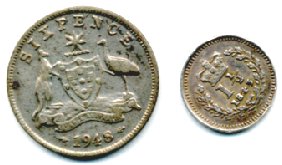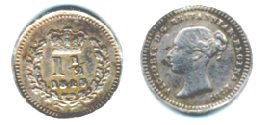MYSTERIOUS TINY COIN FOUND
by our numismatics correspondent William "Bill" Hardy
During one of the COVID-19 lockdowns in April 2022, I unearthed a forgotten metal detector in my attic and needing to get out for some solitary "fresh-air" pandemic exercise, scanned a nearby
piece of Coogee's often-passed by rarely walked-over piece of vacant land with the detector. It was near a bus-stop that had been in place for decades and so after some time discovered, in
addition to a few bits of scrap metal, a number of small coins. There were 3 each of the discontinued Australian 1 and 2 cent coins and two "silver" five cent coins. Plus, hard to believe, one
US cent and an old pre-Euro German pfennig. I guessed that these may have been coins discarded by bus passengers sorting out their change for the bus fare.
Mysterious Find
Just as I was about to pack up, I heard a ping on the detector that registered as non-ferrous. I dug around in the piece of Coogee' sandy soil at first not locating the source of the ping and then when
I was about to give up, caught sight of glimmer of silver. I gingerly brushed the sand aside and saw a tiny, tiny coin that had the unmistakable impression of a "young" Queen Victoria on its face.
At first I thought it was an old pre-decimal silver threepenny piece, but when I picked it up, I realised it was much too small, about half the size. At home, I rinsed it in clean water and looking at it under the
magnifying glass could see it was a Victorian-era British coin from 1843 marked 11/2 pence.

Sixpence and Three Halfpence coin size comparison
Valuable Treasure?
It was a coin and denomination I had never come across before and so I consulted a silver coin specialist on the phone. She said it sounded like a 'maundy' coin and referred me onto another
collector who specialised in British silver coins. These, she said, are only minted in small numbers, quite rare and could be potentially very valuable. I was excited to have found what could have
been possibly valuable treasure.

Found 1843 Three Halfpence Coin
Maundy Coin?
But first a little research about maundy. Maundy Thursday is the day before Good Friday and is an Anglican celebration. At the service held in a different Anglican church each year, the British monarch or a royal official ceremonially
distributes small denominations, specially struck silver coins known as "Maundy money" as symbolic alms to the poor and distressed. The coins are legal tender in Britain but do not circulate because of
their silver content and numismatic value. My British silver collector said, however, that maundy coins had never been issued in 11/2 pence values and it was not a coin she knew that
had officially circulated in Britain. The image of the coin I emailed her, she said, also showed too much ware to have been a coin, such as a maudny, that was really just a collectable.
So, was it worth a lot? "Could be" she said "try searching the net using 'three halfpence' as the search term.".
Solved
Using 'three halfpence' soon yielded a result. United Kingdom three halfpence coins were minted under William IV and Queen Victoria from 1834 to 1862. The obverse features the monarch of
the time, encircled by a legend describing their official titles. The reverse shows '1 1/2', then the date, surrounded by a wreath, with the royal crown above. Weighing around 0.7 grams, and with a
diameter of just 12mm, these coins are tiny. There are eight to a shilling or 160 to a pound. They are made of .925% sterling silver and about 475,000 were minted for 1843.
Colonial Use Only
The three halfpence was minted exclusively for colonial use. To control its Empire and keep the "natives" quiet, in addition to gunboats, redcoats and la-de-da, Britain needed lots of small change. This is
the reason early New South Wales colonial governments created the 'holey dollar' and the 'dump' from Spanish dollars. Bags of 4,000 of these tiny three halfpence coins worth £25 were exported to British colonies
mainly Jamaica, the West Indies and Senegal.
Treasure or Bargain?
So how did this coin end up behind a Coogee bus-stop 177 years later? A little mystery that will never be sold. One mystery solved, though, it is not particularly valuable - if you were generous about
its condition, at most $25 Australian.
|

